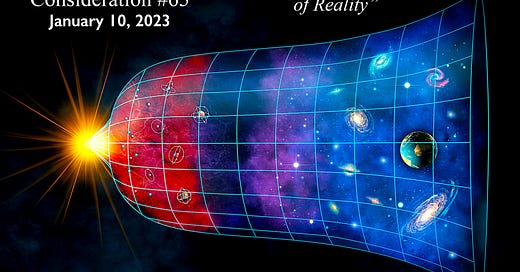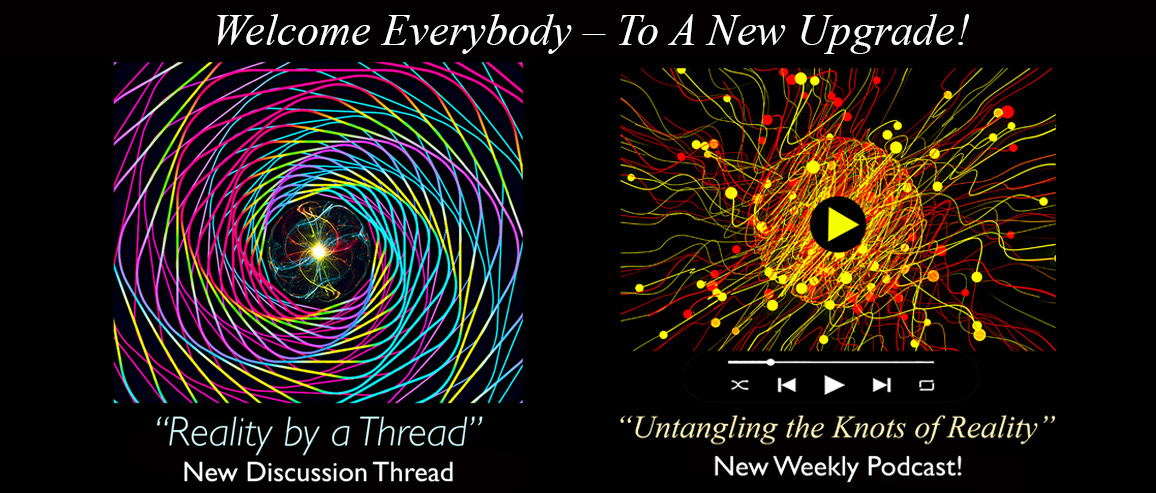How Things Work: A Brief History of Reality
BOOK II: The Power of Three – "#65. Einstein's New Perception of Reality"
Be A Part of the Conversation!
Tuesday, January 10, 202
“General relativity is the cornerstone of cosmology and astrophysics. It has also provided the conceptual basis for string theory and other attempts to unify all the forces of nature in terms of geometrical structures.”
– Paul Davies
PREFACE
“When you drive your car, E = mc2 is at work. As the engine burns gasoline to produce energy in the form of motion, it does so by converting some of the gasoline's mass into energy, in accord with Einstein's formula.”
- Brian Greene
Welcome Everybody!
We often think of Einstein and his theories as an impenetrable enigma that has no connection to our daily lives or experience. However, the truth is, our current conception and understanding of Reality is defined by it. The “Nuclear Age” of science begins a transition from understanding Reality through a “science of the senses” that could be basically understood by the “average” person, to a new “rational” explanation of the “abstract” building blocks of that reality, which were inaccessible to those senses, and those uneducated in the knowledge and language of science.
“Einstein changed the rational and empirical understanding and application of Reality for all of humanity.”
Nevertheless, the results of that abstract rationalism are very tangible. Nuclear Power, Atomic Bombs, Space Travel, Satellites, and the benefits that come from them including Satellite TV, GPS, Weather Forecasting, and Google Earth, are all very “real” things we use every day without thinking about Einstein or his Relativity Theories. Einstein changed the rational and empirical understanding and application of Reality for all of humanity.
“No longer could human beings experience Reality directly through their physical senses…”
In terms of science, Einstein begins a transition from “classical” science to “quantum” science, moving it from a mainly “empirical” discipline to a mostly “rational” discipline. No longer could human beings experience Reality directly through their physical senses; “true” Reality could not be touched, tasted, smelled, seen, or heard; these were merely “human” perceptions and sensations. True Reality, Quantum Reality, was not perceivable through the empirical senses, only through the rational mind.
Einstein’s understanding of Reality moves “modern” science away from the traditional empirical Cartesian view of “How Reality Works” to a more rational Pythagorean concept of “What Reality is.” This radical transformation begins with his Special Theory of Relativity which focuses on the nature of energy and is completed in his General Theory of Relativity which focuses on the nature of gravity.
CONSIDERATION #65 – Einstein’s New Perception of Reality
The Great Unifier
Einstein could be considered the great unifier of science. In his Special Theory of Relativity, he unified waves and particles into photons, space and time into the “space-time continuum,” and revealed the dual nature of reality by unifying the physical and nonphysical in his famous equation declaring the equality of mass and energy E=mc2.
“The Special Theory of Relativity is really a theory that focuses specifically on the nature of light and energy.”
The reason the theory is “special” is because it focuses only on objects moving at a constant speed on a straight line. Photons, light, or energy moves in a straight line at a constant velocity of 186,282 miles per second. The Special Theory of Relativity is really a theory that focuses specifically on the nature of light and energy. However, Einstein’s Special Theory of Relativity is just the first of two revolutionary theories. Einstein’s General Theory of Relativity would consider everything else.
“Gravity is the third factor, that when added to time and space, manifests what we call the universe.”
Einstein’s General Theory of Relativity is about one thing, gravity. However, that one thing is responsible for why light and other objects do not travel in straight lines at constant velocities; everything not explained in the Special Theory of Relativity. Gravity is the third factor, that when added to time and space, manifests what we call the universe. General Relativity is so perplexing, that even Einstein could not bring himself to accept all of its predictions. Here’s how it works.
POSTSCRIPT
After solving the paradox of light, energy, and matter, Einstein turns to the most perplexing problem facing modern science, gravity. Although Isaac Newton had found a “solution” that allowed classical physics to work and evolve, it turned out, by Newton’s own admission, to be no real solution at all. Newton had developed a functioning “working solution” to the problem of gravity without ever actually explaining what gravity was or how it worked. His solution was so successful that for years classical scientists never questioned it. Einstein did.
Next week we begin to consider the problem that Newton could not solve, gravity.
Thank you for reading How Things Work: A Brief History of Reality. This post is public so feel free to share it.
Expand the Conversation by Upgrading to “Reality by a Thread!”
Excerpt from Tomorrow’s Untangling the Knots of Reality – Podcast #31: "Connecting the Dots: Untangling the New Republic"
This Week on “The Thread”:
•Untangling the Knots of Reality: #31 "Connecting the Dots: Untangling the New Republic" (“Abraham Lincoln once said, “You can please some of the people all the time, you can please all the people some of the time, but you can’t please all the people all the time!” However, politicians often attempt to please all the people all the time. This means they stop telling people the truth. However, this could not happen if we were not hungry for the lies…” )
•Reality by a Thread (Discussion Thread): Political Parties - Part 1 “The political structure of the United States was not based on “political parties.” The concept of political parties does not exist in the Declaration of Independence, the Constitution, or the Bill of Rights. However, the speeches and letters of the founders indicate that political parties were, in fact, a major concern, fearing they could “fracture” the new “enlightened” concept of government through the corruption of power. George Washington specifically warned against a “two party” system that would devolve into two “power centers” competing for their own increase in power, as opposed to “objective empirical goals” that were beneficial for their constituents. Washington believed, that above all else, this was the most dangerous challenge to the new “Democratic Republic,” which was based on representative self-government...”)
•FREE PDF Download of Book IV: “The Cosmic Symphony – Overtones of String Theory” plus other discounts and benefits.
UPGRADE NOW!
New & Now Available! – CLICK IMAGE to learn more





